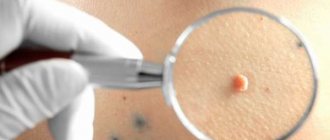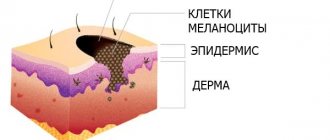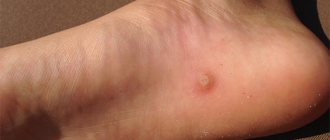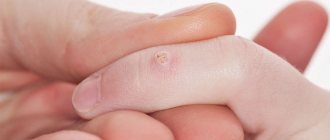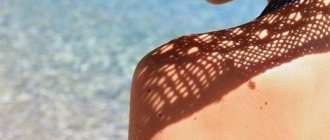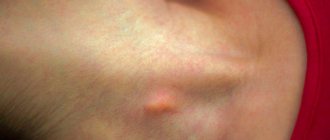And which of the women or girls has not suffered because an unexpected mole suddenly appeared, and even where you don’t want to see it at all? And then such unwanted moles that appear on open areas of the body cause their owners a lot of trouble and worry. And if it is also large in size, for example, or suddenly appears, for example, on the face, then very often this turns into a real tragedy.
Of course, moles do not cause any harm to health, but they cause a lot of trouble. So, they not only spoil the appearance, but are also often located in places where they are easy to injure. It is believed that moles, under the influence of certain factors, can degenerate into malignant formations. And therefore, women began to very often resort to removing moles from their bodies.
Removing moles on the face
Is the appearance of moles a natural phenomenon?
A mole is a small pigmented area of skin that indicates congenital defects or acquired cancer. The size of such formations can vary from several millimeters to tens of centimeters. Moles can also have different pigmentation - from slightly reddish to black. They may or may not be convex, they may or may not have hair growing on them - in any case, any such manifestation is normal from a medical point of view.
Important ! The only sign that it’s time to worry is the appearance of moles after a long exposure to the sun or when they appear and disappear regularly. If this occurs, you should immediately consult a doctor.
A mole is most often a normal phenomenon
Is it possible to remove moles on the face?
The skin of the face is most often exposed to the negative effects of ultraviolet radiation. Therefore, moles and pigmentation most often appear on it. Usually nevi do not cause inconvenience to their owners. But if there are changes in them (color, size, texture), medical supervision may be required .
Removal of flat moles
Flat moles are among the calmest. They rarely become malignant. Most often, their removal occurs due to aesthetic discomfort that they can cause.
Which nevi need to be removed
Moles that are characterized by the following symptoms are subject to removal:
- redness;
- itching and peeling;
- the appearance of painful sensations;
- color change;
- change of size ;
- change in the surface of the nevus ;
- change in the edges of the neoplasm .
Such changes in the structure of formations are a reason to consult a doctor. An oncodermatologist conducts an examination and selects the type of procedure required.
When tumors cannot be removed
It is recommended to refrain from removing nevi in the following cases:
- acute inflammatory diseases;
- pregnancy.
Otherwise, if the tumor does not cause any inconvenience to its owner, doctors recommend refraining from removing it.
Moles and their classification
Moles, or, as is not often said, nevi, can vary in size:
- small (no more than 2 cm);
- medium (size can reach 12 cm);
- large (all moles are larger than 12 cm);
- very large (partially or completely covering any part of the body).
Nevi are also divided into epidermal, intradermal and borderline. Epidermal moles are those that are formed by the accumulation of pigment in the upper layer of the skin. Intradermal - nevi located one layer deeper than the epidermis. Borderline are those moles that cannot be classified into any of the listed categories. They are located between both layers of the skin, which is why they have this name.
Important ! In addition, nevi can be located on the mucous membrane and on some organs.
There are different types of nevi
There are many other signs that together form different types of moles. Some of them are: shape, color, location on the body and others. Taking them into account, moles can be divided into several types.
- Hemangiomas are pigmented spots of blue, scarlet or pinkish color.
- Anemic formations are a light accumulation of underdeveloped cells.
- Non-vascular - moles that can have different colors (from reddish to black). They also stand out due to their roughened surface.
- Setton moles are nevi that do not cause any harm, appearing on the upper layer of the epidermis.
Setton moles
- Nevus of Ota is an accumulation of pigment that forms one or several spots of blue or dark brown color, mainly located on the face - the areas of the upper eyelid, chin and cheeks most often become “victims” of such moles.
- Ito's mole is a formation of the epidermis similar in appearance to Ott's nevus. The key difference is the location - these moles usually appear in the area of the collarbones and shoulder blades.
- Bluish nevi are distinguished by their characteristic blue or more often blue color. Smooth to the touch.
- Dysplastic - moles not exceeding 15 mm in length, having an unclear shape with blurred boundaries, mostly brown in color.
- Becker's moles are pigment spots with hairs on their surface (in most cases, the owners are men).
Becker's moles
Important ! It's no secret that moles are sometimes an indicator of tumor processes, so when you see new nevi, completely healthy fears arise in your head. How to understand what “message” from the body suggests a neoplasm? Is it harmless?
First you need to see a doctor. Only he will be able to accurately determine whether it is worth worrying about, or whether this mole is just another feature of the body. In no case should you self-medicate or, on the contrary, leave everything to chance - you can only make things worse.
The doctor will tell you for sure whether everything is fine with your health or not.
Experienced specialists divide nevi into two groups.
- Melanoma-hazardous (moles indicating the presence of tumor processes in the body). Such pigment spots may subsequently become one of the prerequisites for the occurrence of cancer.
- Melanoma-dangerous (nevi that do not carry any “negative” in their appearance). Such moles do not cause any harm to the body, so their removal is not necessary.
By the type of mole you can determine the presence or absence of dangerous processes
In addition to moles, there are also formations that look very similar to them - warts and papillomas. And if a mole is an accumulation of pigment, then papilloma is a manifestation of the virus of the same name. Unlike a mole, a papilloma brings much more discomfort. It is attached to the skin, but is located slightly higher, forming a “hanging” mole.
Important ! Unfortunately, the percentage of people who have papillomas is rapidly approaching 70%. At the moment, more than half of the world's population carries this virus in their bodies, thereby infecting others - it is transmitted not only through sexual contact, but in general through any contact with an “infected” person.
Today, more and more people are suffering from an increase in the number of papillomas
A wart is a type of papillomas that causes exclusively negative emotions. For the most part, it is absolutely safe, but its appearance leaves much to be desired. It is the latter factor that is the reason that more and more people are trying to remove it. Fortunately, this is not difficult to do - just visit the nearest pharmacy and purchase a product designed to remove this formation. However, before undertaking treatment, it is necessary to consult a specialist. The reason for this is the presence of nuances that must be taken into account. With insufficient treatment, an incompletely cured area of skin can become inflamed and even cause skin cancer.
Warts should be removed after consultation with a doctor.
If the decision to undergo treatment has already been made, it is necessary to approach it with maximum responsibility - you should consult a doctor and undergo histological tests.
Important ! Despite the fact that most age spots cause discomfort only because of their appearance, under no circumstances should you turn to cosmetologists. Their knowledge is not enough to make any diagnosis and prescribe a course of treatment. It is best, if possible, to visit a special office where doctors are specialists in working with various types of moles and papillomas, so they can help you with your problem, eliminating any kind of consequences to the maximum.
It is necessary to undergo histological tests
What are moles?
A mole is a benign formation on the skin. In the professional language of doctors, a mole is a nevus. This area of the skin is pigmented due to the accumulation of a large amount of melanin in the cells. The more pigment there is under the skin, the darker its color.
Varieties
Pigmented formations can be of various shapes and sizes, flat and convex. It is noteworthy that over time, some of them change. Moles are classified according to their size:
- small, not exceeding 1.5 cm;
- medium, up to 10 cm in diameter;
- large, occupying an area of more than 10 cm.
Depending on the place of formation, moles are:
- intradermal, located in the deep layers of the skin;
- epidermal, occurring in the epidermis;
- mixed, occupying a borderline position between the upper and inner layers of the skin.
How to distinguish a dangerous mole from a safe one?
Despite the fact that there are many “normal” manifestations of moles, there are factors that indicate their unnatural occurrence. One of them:
- nevi larger than 15 cm;
- moles that change shape over time;
- “growing” moles;
- nevi without clear boundaries;
- change in pigment color;
- the presence of an asymmetrical shape of the mole;
- the appearance of “glossy” on the surface;
- the appearance of causeless moisture on the surface;
- the presence of a crust;
- itching and other unpleasant sensations;
- bleeding mole;
- change in skin density in the area where the pigment is located;
- the appearance of nodules on the surface;
- loss of hair growing directly on the nevus.
There are many factors that can give a hint about the presence of pathological occurrence of moles
Important ! If at least one of the listed signs is noticed, you should immediately consult a doctor. Most likely, he will prescribe removal of this mole, and will also refer you to other specialists who will help understand its origin.
Of course, there are situations where removal of a nevus is necessary, but besides this, there are many other factors that can influence the decision to get rid of an unwanted formation. For example, common reasons for removing nevi are reluctance to have them on your body, an inconvenient location that causes discomfort when moving. Nevi often cling to elastic bands, chains and hair, as a result of which they can be injured, which is extremely dangerous. Damaged moles can lead to inflammation and cancer, therefore, if discomfort occurs, it is important to immediately consult a doctor.
Often moles get rid of
It is worth noting that if the decision to remove such a formation has already been made, it is necessary to decide on the season when the mole will be removed. This is very important, because if you remove a mole that appeared during a period of large amounts of sunlight, in hot weather, many complications may arise, as well as the appearance of similar moles in the same place.
Important ! However, if the nevus is potentially dangerous, it should be removed as soon as possible, regardless of such natural factors.
It is necessary to determine the specific time for nevus removal
Reasons for removing moles
Most often, moles appear in children and adolescents. This is caused by the fact that some hormonal changes begin in the child’s body. In adults, birthmarks begin to appear in middle age.
The reasons for the formation of birthmarks in an adult can be a variety of injuries, hormonal therapy, massage, and even the most ordinary sun. Among such birthmarks you can also find dangerous ones, which are best removed.
So, the main reasons for removing birthmarks:
- the birthmark suddenly begins to grow sharply and increases greatly in size;
- forms and boundaries suddenly begin to change;
- unpleasant sensations appear in the place where the birthmark formed. It may be pain, itching or even a burning sensation;
- unexpectedly the birthmark begins to change its color;
- Every time clothing touches a mole, it is injured.
You can often see in the photo that before the removal of the birthmark, a woman was shy, embarrassed and did not look very good, but after such removal she simply blossomed. Removing a birthmark often gives a woman not only peace of mind, but also some self-confidence.
Which removal method should I choose?
There are several ways to remove nevi.
Surgical removal . This method is the most reliable. The surgeon removes the area of skin where the mole is located. The doctor cuts off a potentially infected area of skin, the inflammation from which can spread to others.
Pros:
- acceptable price;
- no contraindications;
- the ability to take an analysis to confirm that the operation was carried out successfully;
- reliability.
Minuses:
- the appearance of a scar after surgery;
- the possibility of using this method only on small areas of the skin;
- undesirable use when removed in visible places.
Surgical removal
Removing moles with nitrogen. This method, like the previous one, is used to remove small moles. Liquid nitrogen is applied pointwise to the damaged area, after which a bubble appears at this place, turning into a crust within a couple of weeks. After a short time, it dries up and falls off on its own.
Pros:
- ideal for removal in visible places;
- absence of any painful sensations;
- no marks on the skin;
- acceptable price;
- no risk of re-infection;
- the procedure will be carried out as soon as possible.
Minuses:
- inability to take an analysis, as a result of which the ability to find out about an incompletely removed mole or papilloma in the shortest possible time will become impossible;
- due to the unexpected reaction of liquid nitrogen, it is impossible to accurately determine whether it will affect a healthy area of skin;
- due to the fact that it is impossible to predict the reaction of liquid nitrogen, it is impossible to determine with accuracy whether the mole will be completely removed or not.
Nitrogen removal
Using an electrocoagulator . This method is as simple as possible to use - the doctor uses a special device that, using an electric current charge, acts on a papilloma or mole, depriving the internal nerve of sensitivity and thereby eliminating the possibility of subsequent inflammation.
pros
- absence of pain;
- safety;
Minuses:
- a trace may remain, so the procedure is not recommended for removing moles in visible places.
Electrocoagulator
Laser therapy . This method is suitable for removal in visible places.
Pros:
- painlessness;
- eliminating the possibility of infection;
- fast speed of operation;
- no scars;
- no bleeding;
- rehabilitation will not take long - thanks to the special principle of operation, the wound will heal in the shortest possible time;
- lack of care as such.
Minuses:
- There is no possibility to send skin samples for histological analysis after the operation, which leaves the risk of re-inflammation. Therefore, carrying out such a procedure would be an ideal option if the mole is not fundamentally dangerous.
Laser therapy
Radio wave excision . This method can be confidently called the best. It involves removing moles using high-frequency radio waves.
Pros:
- the ability to take a sample for analysis;
- painlessness;
- the procedure is carried out quickly;
- no traces;
- zero risk of inflammation.
Minuses:
- Compared to other methods, this price is slightly higher.
Radio wave excision
Traditional removal methods
The Internet is full of recipes and various methods that are considered effective in removing moles and papillomas. However, their benefits remain controversial - using them risks only aggravating the situation. That is why you should not trust the dubious advice of a complete stranger who does not provide any confirmation of his words besides personal experience.
It's better not to use folk remedies
What to do if the nevus or papilloma was injured?
Since childhood, everyone knows that it is better not to touch a mole again, so as not to injure it. And these words are not at all groundless - a mole, even a small one, can bring a lot of trouble to its owner. But what to do if troubles could not be avoided?
First, you should stop the bleeding, and then immediately consult a doctor. If the object of observation has been completely stripped, it should be preserved and submitted for analysis.
First aid for a mole injury
First you need to stop the bleeding. By applying a cotton swab with hydrogen peroxide, you can not only reduce or even stop bleeding, but also disinfect the area with the wound. Afterwards, you should carefully protect the affected area so that nothing gets there.
Important ! This is very important, because one virus is enough to start a process that will be very difficult to stop.
Correct adherence to instructions will prevent the occurrence of diseases
But, if the mole has been torn off or injured, and enough time has passed, you can determine for yourself whether it is benign or not. Several main signs that education is potentially dangerous:
- it began to grow;
- density has changed;
- color has changed;
- the “scene of the incident” is painful or itchy;
- redness appeared around;
- hair growing at the site of damage falls out;
- the area around the injured area turns red and becomes irritated.
Contraindications for removal:
- the presence of inflammatory processes in the body;
- unhealthy appearance of the skin that will have to undergo the procedure;
- pregnancy;
- menstruation;
- presence of herpes;
- diabetes;
- the patient is breastfeeding.
Contraindications must be taken into account
Important ! Despite the fact that any troubles related to moles and papillomas are quite dangerous, they are not fatal.
People don't die from picking off a mole. First of all, the consequences of improper care immediately after injury, as well as incomplete removal, lead to death.
This problem is not too dangerous
Indications for removal
Indications for nevus removal can be personal or medical. The first are limited by the patient's wishes. If a tumor spoils your appearance, you can easily consult a dermatologist and get rid of this cosmetic defect.
Medical indications are based more on physical changes and discomfort. The procedure is carried out to prevent the degeneration of benign formations into malignant ones. A mole should be checked when it:
- changed color - the spots should be colored evenly;
- has grown - small nevi can also pose a danger, but an increase in size, especially a sharp one, should be the reason for a visit to a dermatologist;
- has changed shape - the boundaries of neoplasms are usually clear and even;
- itches, hurts or bleeds - the spots should not bother you at all;
- changed structure or shape. If a mole suddenly becomes convex, becomes crusty, cracked or peeling, or the hairs growing on top fall out, it is better to show it to a doctor.
It is recommended to remove marks on the face that are subject to constant mechanical stress.
These are moles located at the edge of the hair, in the eye area or on the chin - in areas that are rubbed by glasses or damaged during shaving or combing.
How much does it cost to get rid of such a problematic body feature?
This procedure requires a responsible approach and full readiness for numerous analyses. The cost of removing moles depends on their size, location and method of destruction. It is worth considering that you will have to pay not only for the procedure itself, but also for preparation for it.
Important ! In order to begin deletion, you will need to pay about 2 thousand rubles.
The price depends on the scope of work
It is clear that each clinic sets its own price, but by comparing the prices of most clinics, you can derive an average value.
| Type of procedure | Price |
| Removal of moles up to 1 cm with laser | 1500 rub. |
| Removing moles from 1 cm with laser | 2500 rub. |
| Laser removal of small rashes | From 3000 rubles (up to 5 pieces), from 3500 rubles (from 5 pieces), 4600 rubles (from 10 pieces). |
| Liquid nitrogen removal | From 500 to 2500 rub. |
| Removal in the surgeon's office | From 2000 to 6000 rub. |
| Radio wave excision | 4500 rub. |
| Electrocoagulation of a mole | From 800 to 3000 rub. |
The cost of the procedure is influenced by various factors
Reviews
Irina, Saratov
“I was removing a mole, which did not affect my health in any way, it was simply in the way because it was constantly clinging to the chain hanging on my neck. I decided to remove it with liquid nitrogen - it was quick, the rehabilitation was short, and the price was reasonable. I came, having previously visited all the necessary doctors. They treated me, burned me, and told me not to go out in the sun, but this was understandable - it was late winter outside. The wound healed faster than in 2 weeks - after all, the mole was small. A small light spot remains, but it is hardly noticeable on the skin. I am very pleased with the result, I recommend it to anyone who asks for advice. Six months have passed, and I have never regretted it.”
People are happy with the procedure
Ksenia, Voronezh
“I had a mole removed surgically because... There were suspicions of cancer. Fortunately, they were not confirmed. I didn't like that mole anyway, so I'm glad it's gone. I understand that this is a rather “outdated” method, but there was a chance to send the material for examination. There is a small scar left, but it seems only I can see it. The doctor did everything very carefully, there were no complications. So I advise you not to worry and, if necessary, remove such tumors.”
Nikolay Kolyuzhny, surgeon
“Never treat choosing a clinic with disdain, do not leave everything to the last minute. It is very important that the doctor is an expert in his field, because removing a mole is a process that requires certain knowledge and specific skills. The wrong attempts to solve a problem can backfire in the future and lead to problems that will be incredibly difficult to fix.”
Photos before and after
Photos before and after laser mole removal
Photos before and after mole removal with liquid nitrogen
Photos before and after surgical removal of a mole
Photos before and after radio wave excision of a mole
Photos before and after electrocoagulation of a mole
Possible complications and consequences after removal of a nevus
The most common complication of mole removal is wound infection. This is due to the lack of qualifications of the specialist who performed the operation. In addition, a dangerous postoperative condition is the reappearance of a pigmented formation.
Each method of eliminating a nevus has its own consequences:
- Possibility of an allergic reaction to laser radiation.
- The appearance of burns and injury to healthy tissues during cryodestruction.
- Scar formation on the skin after surgery and exposure to electric current.




